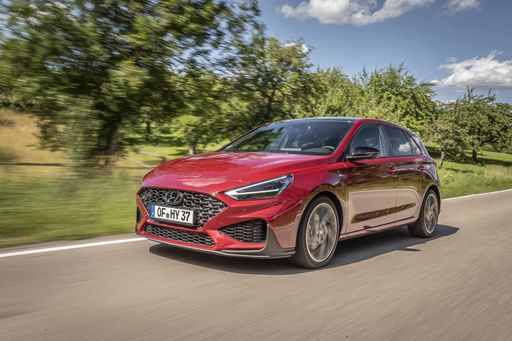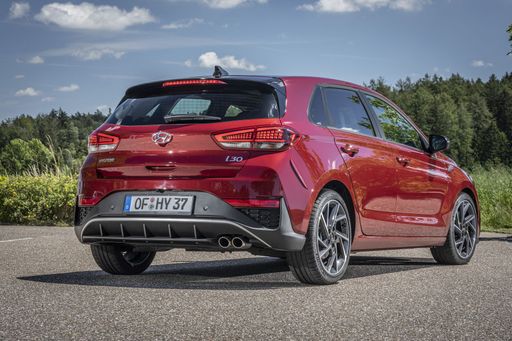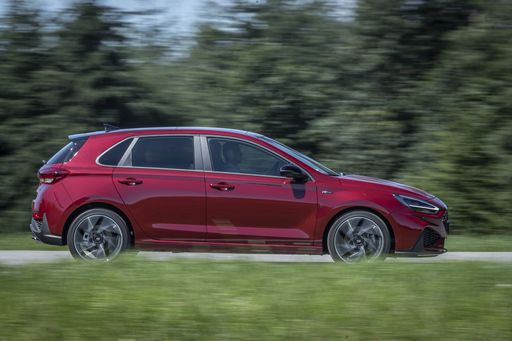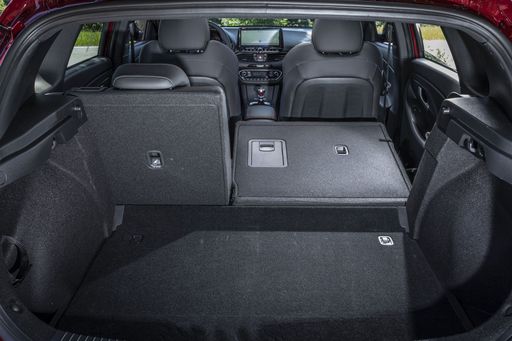Hyundai i30 vs Mazda 3 Sedan – Differences & prices compared
Compare performance, boot space, consumption and price in one view.
Find out now: which car is the better choice for you – Hyundai i30 or Mazda 3 Sedan?
The Hyundai i30 (Hatchback) comes with a Petrol or Petrol MHEV engine and Manuel or Automatic transmission. In comparison, the Mazda 3 Sedan (Sedan) features a Petrol MHEV engine with Manuel or Automatic transmission.
When it comes to boot capacity, the Hyundai i30 offers 395 L, while the Mazda 3 Sedan provides 450 L – depending on how much space you need. If you’re looking for more power, decide whether the 140 HP of the Hyundai i30 or the 186 HP of the Mazda 3 Sedan suits your needs better.
In terms of consumption, the values are 5.70 L per 100 km for the Hyundai i30, and 5.50 L for the Mazda 3 Sedan.
Price-wise, the Hyundai i30 starts at 24000 £, while the Mazda 3 Sedan is available from 25000 £. Compare all the details and find out which model fits your lifestyle best!
In the competitive compact car segment, the Hyundai i30 and Mazda 3 Sedan stand out with distinct attributes. The Hyundai i30 appeals to practical drivers with its roomy interior and advanced tech features, offering exceptional value for money. Meanwhile, the Mazda 3 Sedan captivates enthusiasts with its sleek design and fun-to-drive dynamics, thanks to its responsive handling and refined powertrain.
Hyundai i30
The Hyundai i30 stands out in the hatchback segment with its sleek design and modern features. It offers a comfortable ride with a well-crafted interior that caters to both driver and passengers. With its emphasis on safety and technology, the i30 provides a balanced driving experience suitable for urban and suburban environments.
details @ hyundai.news
@ hyundai.news
 @ hyundai.news
@ hyundai.news
 @ hyundai.news
@ hyundai.news
 @ hyundai.news
@ hyundai.news
 @ hyundai.news
@ hyundai.news
Mazda 3 Sedan
The Mazda 3 Sedan stands out with its elegant and sleek design, capturing attention on the road with its refined aesthetics. Inside, it offers a well-crafted and comfortable cabin, providing a pleasurable driving experience marked by quality materials and advanced features. The car's performance is reliable and smooth, making it a versatile choice for both city driving and long-distance journeys.
detailsThe Battle of Compacts: Hyundai i30 vs. Mazda 3 Sedan
In the ever-evolving landscape of compact cars, two strong contenders are staking their claim: the Hyundai i30 and the Mazda 3 Sedan. Both geared for the discerning driver, these models bring a host of innovative features and robust technical specs that promise a thrilling experience on the road. Let’s delve into the specifics and see how they compare.
Engine Performance and Efficiency
The Hyundai i30 offers a choice between petrol and petrol mild-hybrid electric vehicle (MHEV) engine types, providing flexibility for buyers focusing on power and efficiency. The 1.0-liter three-cylinder engine delivers a modest 100 HP, while the more potent 1.5-liter four-cylinder boosts output up to 140 HP. Both variants keep fuel consumption low, ranging from 5.6 to 5.9 L/100 km.
On the other hand, the Mazda 3 Sedan packs a punch with its 2.0-liter and 2.5-liter petrol MHEV engines, churning out between 140 and an impressive 186 HP. Despite the higher power output, the Mazda maintains fuel efficiency with consumption between 5.5 and 5.9 L/100 km, thanks to its advanced Skyactiv technology.
Transmission and Driving Dynamics
Both the i30 and Mazda 3 offer manual and automatic transmission options, emphasizing the importance of a personalized driving experience. Hyundai's dual-clutch automatic gearbox ensures a smooth shift, enhancing the driving pleasure of the i30.
The Mazda 3 handles transmission duties with a keen focus on driving dynamics, thanks to its fine-tuned automatic and manual gearboxes that deliver a responsive and engaging ride. Front-wheel drive configurations in both vehicles ensure optimal power distribution and fuel economy.
Design and Dimensions
When it comes to aesthetics, the Hyundai i30, with its hatchback design, offers a compact form that is perfect for urban environments. It measures 4,340 mm in length, 1,795 mm in width, and 1,455 mm in height, providing a well-balanced appearance and a functional 395-liter trunk capacity.
The Mazda 3 showcases a sleek sedan profile, stretching 4,660 mm in length with the same width of 1,795 mm, albeit slightly lower in height at 1,440 mm. It offers a more spacious trunk capacity of 450 liters, making it a practical choice for longer journeys.
Interior Space and Features
Both cars comfortably seat five occupants, paying close attention to interior ergonomics and comfort. The Hyundai i30’s cabin is space-efficient and modern, with intuitive controls and ample room for front and rear passengers. It weighs between 1,291 to 1,407 kg, contributing to its agile handling.
The Mazda 3's interior is a step up with premium materials and a driver-centric design. It boasts a slightly higher curb weight ranging from 1,420 to 1,492 kg, which adds to its substantial on-road presence and comfort in driving.
Safety and Technology
When it comes to safety, both models come equipped with a robust suite of driver-assistance technologies. The Hyundai SmartSense system offers adaptive cruise control, lane-keeping assist, and emergency braking, among others.
The Mazda 3 is not far behind, boasting the i-Activsense safety suite which includes features like rear cross-traffic alert, lane departure warning, and adaptive cruise control. Both cars sit in the CO2 efficiency class D, with the i30 emitting between 126-133 g/km of CO2, while the Mazda 3 ranges from 123-135 g/km.
Conclusion
Choosing between the Hyundai i30 and the Mazda 3 Sedan requires careful consideration of one's priorities. For drivers prioritizing agility, urban maneuverability, and a variety of engine options, the i30 stands out. Conversely, the Mazda 3 appeals to those seeking enhanced power, a more luxurious interior, and superior trunk space.
Ultimately, both cars offer compelling packages with advanced technological features and admirable performance characteristics, making either choice a testament to modern automotive engineering.

|
|
|
|
|
Costs and Consumption |
|
|---|---|
|
Price
24000 - 29300 £
|
Price
25000 - 34200 £
|
|
Consumption L/100km
5.7 - 6 L
|
Consumption L/100km
5.5 - 6.1 L
|
|
Consumption kWh/100km
-
|
Consumption kWh/100km
-
|
|
Electric Range
-
|
Electric Range
-
|
|
Battery Capacity
-
|
Battery Capacity
-
|
|
co2
130 - 136 g/km
|
co2
123 - 135 g/km
|
|
Fuel tank capacity
50 L
|
Fuel tank capacity
51 L
|
Dimensions and Body |
|
|---|---|
|
Body Type
Hatchback
|
Body Type
Sedan
|
|
Seats
5
|
Seats
5
|
|
Doors
5
|
Doors
4
|
|
Curb weight
1291 - 1407 kg
|
Curb weight
1420 - 1492 kg
|
|
Trunk capacity
395 L
|
Trunk capacity
450 L
|
|
Length
4340 mm
|
Length
4660 mm
|
|
Width
1795 mm
|
Width
1795 mm
|
|
Height
1455 mm
|
Height
1440 mm
|
|
Payload
463 - 509 kg
|
Payload
467 - 481 kg
|
Engine and Performance |
|
|---|---|
|
Engine Type
Petrol, Petrol MHEV
|
Engine Type
Petrol MHEV
|
|
Transmission
Manuel, Automatic
|
Transmission
Manuel, Automatic
|
|
Transmission Detail
Manual Gearbox, Dual-Clutch Automatic
|
Transmission Detail
Manual Gearbox, Automatic Gearbox
|
|
Drive Type
Front-Wheel Drive
|
Drive Type
Front-Wheel Drive
|
|
Power HP
100 - 140 HP
|
Power HP
140 - 186 HP
|
|
Acceleration 0-100km/h
9.6 - 13.1 s
|
Acceleration 0-100km/h
8.1 - 9.8 s
|
|
Max Speed
178 - 197 km/h
|
Max Speed
203 - 216 km/h
|
|
Torque
172 - 253 Nm
|
Torque
238 - 240 Nm
|
|
Number of Cylinders
3 - 4
|
Number of Cylinders
4
|
|
Power kW
74 - 103 kW
|
Power kW
103 - 137 kW
|
|
Engine capacity
998 - 1482 cm3
|
Engine capacity
1998 - 2488 cm3
|
General |
|
|---|---|
|
Model Year
2024
|
Model Year
2025
|
|
CO2 Efficiency Class
D, E
|
CO2 Efficiency Class
D
|
|
Brand
Hyundai
|
Brand
Mazda
|
Hyundai i30
Introducing the Hyundai i30: A Blend of Performance and Innovation
The Hyundai i30 continues to impress the automotive world with its fine balance of performance, efficiency, and cutting-edge technology. As a quintessential hatchback, the i30 caters to a diverse range of drivers, offering a remarkable driving experience through its impressive powertrains and compact yet stylish design.
Dynamic Performance Options
At the heart of the Hyundai i30 lies a variety of engine choices designed to suit different driving preferences. The power output ranges from 100 PS to 280 PS, allowing drivers to choose an i30 that perfectly matches their performance needs. Whether you're inclined towards the spirited drive of the N Performance variants or prefer the efficiency of the mild hybrid versions, there’s a powertrain tailored for you.
Innovative Hybrid Technology
For those seeking enhanced fuel efficiency without compromising on power, the i30’s 48V mild-hybrid system offers a compelling option. Available with both manual and automatic transmissions, this innovative technology provides an ideal balance, reducing emissions and improving fuel consumption, with an impressive average of just 5.7 L/100km.
Sophisticated Design and Features
The Hyundai i30’s sleek design is complemented by thoughtful interior features that elevate the driving experience. With a boot space ranging from 395 to 450 litres, this hatchback ensures ample room for all your luggage needs. Furthermore, the car's aesthetic appeal is matched by its practical ergonomic layout, catering to both style enthusiasts and those seeking functionality.
Advanced Safety and Technology
The i30 is equipped with an array of advanced safety features, enhancing driver confidence and ensuring passenger safety. Its cutting-edge safety suite includes lane-keeping assist, forward collision warning, and adaptive cruise control. Additionally, the i30 offers a modern infotainment system, designed to keep you connected and entertained on every journey.
Conclusion: A Versatile Choice for Modern Drivers
The Hyundai i30 is more than just a hatchback; it’s a remarkable amalgamation of power, efficiency, and modern technology. Whether you're enticed by the high-performance models or the eco-friendly mild-hybrid variants, the i30 stands out as a versatile choice that meets the demands of today’s discerning drivers.
Mazda 3 Sedan
Introduction to the Mazda 3 Sedan
Unveiling the 2024 Mazda 3 Sedan, a vehicle that gracefully combines elegance with innovation. This model is an exemplar of Mazda's commitment to pushing the boundaries of design and performance. The Mazda 3 Sedan is available with a choice of engines that blend efficiency with power, ensuring a drive that's as rewarding as it is economical.
Advanced Powertrains
The heart of the Mazda 3 Sedan lies in its cutting-edge engine options. Equipped with a 2.0-litre e-SKYACTIV-X engine, this sedan delivers up to 186 PS while maintaining excellent fuel efficiency. For those seeking a balance between power and efficiency, the e-SKYACTIV-G engine with 140 PS is an ideal choice. Both engines utilize mild-hybrid technology, enhancing performance and reducing emissions.
Efficiency Meets Performance
Boasting an impressive fuel consumption range between 5.5 to 6.1 L/100km, the Mazda 3 Sedan is perfect for both city commutes and long drives. With emissions rated at 123 to 135 g/km, it strikes a sustainable balance without compromising on performance. Acceleration from 0 to 100 km/h takes just 8.1 seconds with the most powerful variant, highlighting its agile character.
Specifications and Pricing
From the entry-level Center-Line to the luxurious Takumi trim, the Mazda 3 Sedan offers a range of equipment lines catering to a variety of tastes and needs. The pricing is competitive, starting from €28,640 and reaching up to €39,390, offering remarkable value for a car of this class. Monthly costs range between €961 to €1080, reflecting its economic viability.
Design and Comfort
The Mazda 3 Sedan’s dimensions (4,660 mm in length, 1,795 mm in width, and 1,440 mm in height) create a sleek profile that underscores its sophisticated design philosophy. Inside, the cabin is spacious, comfortably accommodating five passengers, while the boot offers a practical 450 litres of luggage space, ideal for both daily tasks and longer trips.
Innovative Technology and Features
The Mazda 3 Sedan impresses with a suite of advanced technologies, enhancing safety and convenience. Front-wheel drive ensures stability and control, while advanced driver assistance systems provide support during challenging driving conditions.
Concluding Thoughts
The 2024 Mazda 3 Sedan represents a harmonious blend of performance, efficiency, and modern technology. Its stylish design and innovative features make it a compelling choice for those seeking a sophisticated and reliable sedan. Whether you're after a manual transmission for a more engaged driving experience or the convenience of an automatic, the Mazda 3 Sedan delivers on all fronts.
What drive types are available for the Hyundai i30?
The Hyundai i30 is available as Front-Wheel Drive.
The prices and data displayed are estimates based on German list prices and may vary by country. This information is not legally binding.
